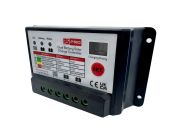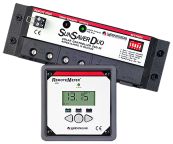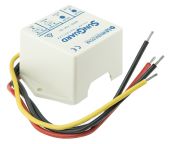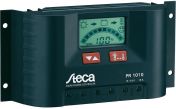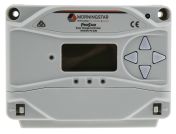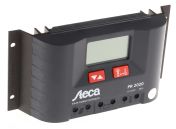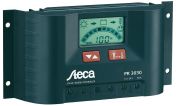Solar Charge Controllers
Solar charge controllers, also known as solar power regulators or solar panel regulators, are essential components in solar power systems. They work by regulating the flow of energy from solar panels to batteries, ensuring optimal charging and preventing damage to the battery bank.
How Does a Solar Charge Controller Work?
Solar charge controllers or solar panel regulators monitor the power flow between the solar panels and the connected battery. Some regulators may simply disconnect the flow of power when the battery is in danger of overcharging. However, more advanced controllers utilise a multi-stage process in which the controllers monitor the flow and, when the battery voltage rises to a predetermined regulation point, they regulate the flow to maintain the voltage for a specific duration. This phase is knows as the "absorption" period, allowing the battery to become fully charged. After the absorption phase, the regulator then switches to a “float” mode, where it maintains the battery at a near-full charge.
Types of Solar Charge Controller
MPPT Solar Charge Controller
Maximum Power Point Tracking (MPPT) solar charge controllers represent the cutting edge of solar technology. These sophisticated devices constantly monitor the solar panel's output, identifying and utilising the maximum power point to ensure you harvest the most energy possible from your solar array. This optimisation is particularly valuable in less-than-ideal conditions, such as cloudy weather or low sun angles. As a result, MPPT controllers are particularly well-suited for larger systems or situations where maximising energy harvest is crucial. Additionally, they can often handle higher voltage solar panels, providing greater flexibility in system design and potentially reducing system costs.
PWM Solar Charge Controller
Pulse Width Modulation (PWM) solar charge controllers offer a simpler and more budget-friendly approach to solar energy management. These controllers regulate the flow of energy to the batteries by rapidly switching the current on and off, essentially pulsing the energy to maintain the desired voltage. This makes them a reliable and cost-effective choice for smaller systems where maximising energy harvest might not be the primary concern. Their straightforward design and operation also make them easier to install and maintain, making them a popular choice for simpler solar power setups.
Benefits of Using a Solar Panel Controller
A solar charge controller is a crucial component in any solar power system, offering numerous benefits that ensure the longevity and efficiency of your setup.
- Prevent Overcharging: By regulating the voltage and current from the solar panels, the controller prevents the batteries from being overcharged, which can damage them and shorten their lifespan.
- Prevent Deep Discharge: The controller also prevents batteries from being completely discharged, which can also cause damage and reduce their overall capacity.
- Optimise Battery Life: By preventing overcharging and deep discharge, the charge controller helps to maximise the lifespan of your batteries.
- Improve System Efficiency: Some controllers, especially MPPT controllers, can optimise the energy harvest from solar panels, improving the overall efficiency of the system.
- System Monitoring: Many modern solar charge controllers offer monitoring capabilities, providing insights into the system's performance and battery status.
Industrial Applications of Solar Charge Controller
Solar charge controllers are versatile devices that find applications across various industries, including:
- Telecommunications: In remote areas without grid access, solar charge controllers provide reliable power for telecommunications equipment, ensuring uninterrupted communication services.
- Oil and Gas: The oil and gas industry utilises solar charge controllers to power remote monitoring and control systems, reducing reliance on diesel generators and minimising environmental impact.
- Agriculture: Solar charge controllers are employed in agricultural settings to power various off-grid applications, such as irrigation systems, livestock watering systems, and remote monitoring equipment.
- Transportation: The transportation sector utilises solar charge controllers in electric vehicles, boats, and recreational vehicles (RVs) to charge batteries and provide auxiliary power, reducing reliance on fossil fuels and promoting sustainable transportation solutions.
How to Select the Suitable Solar Power Regulator
Choosing the right solar charge controller is crucial for ensuring the optimal performance, efficiency, and longevity of your solar power system. Here are some key factors to consider when making your selection:
System Voltage
The voltage rating of the solar charge controller must be compatible with both your solar panel array and your battery bank. Ensure that the controller’s voltage rating matches or exceeds the voltage of your solar panels and batteries. Using a controller with an inadequate voltage rating can lead to damage or malfunction.
Current Rating
The current rating of the solar charge controller indicates the maximum current it can handle from the solar panels. Choose a controller with a current rating that meets or exceeds the maximum current output of your solar panels. This ensures that the controller can handle the full power generated by your solar array without overheating or malfunctioning.
Type of Battery
Different battery chemistries have different charging requirements. Therefore, it is essential to select a solar charge controller that is compatible with the type of battery you are using. Common battery types include lead-acid (flooded, sealed, and gel), lithium-ion, and lithium iron phosphate (LiFePO4). Using an incompatible controller can lead to inefficient charging, reduced battery lifespan, or even damage to the batteries.
MPPT vs. PWM
Consider whether an MPPT or PWM controller is more suitable for your solar power system. MPPT regulators are generally more efficient, especially in low-light conditions, but they are also more expensive. PWM controllers are a more cost-effective option, but they may not be as efficient in maximising energy harvest. The choice between MPPT and PWM depends on your system size, budget, and desired level of efficiency.
How to Know If Your Solar Regulator Works
Ensuring your solar charge controller is functioning correctly is crucial for maintaining the health and longevity of your batteries and the overall efficiency of your solar power system. Here are a few ways to check if your solar regulator is working as it should:
- Monitor Battery Voltage: Regularly monitor the battery voltage using a voltmeter or by checking the display on your solar charge controller. The voltage should remain within the recommended range for your specific battery type. If the voltage consistently reads too high or too low, it could indicate a problem with the charge controller.
- Check for Error Messages or Warnings: Many modern solar charge controllers have built-in displays or indicator lights that provide information about the system's status. Check the controller’s display or indicator lights for any error messages or warnings that might indicate a malfunction.
- Observe Battery Charging and Discharging: Pay attention to how your batteries are charging and discharging. If you notice that the batteries are not charging properly, even in good sunlight conditions, or if they are discharging too quickly, it could indicate a problem with the charge controller.
- Inspect for Physical Damage: Visually inspect the solar charge controller for any signs of physical damage, such as loose connections, burnt components, or corrosion. If you notice any physical damage, it is important to address it promptly to prevent further issues.
By regularly monitoring your solar charge controller and performing these simple checks, you can ensure it is functioning correctly and maintaining the optimal performance of your solar power system.
Trusted Solar Charge Controllers Manufacturer, Supplier and Distributor in Malaysia
RS is a trusted and leading manufacturer, supplier, and distributor of solar charge controllers in Malaysia. We offer a wide selection of high-quality solar charge controllers at competitive prices, catering to various residential, commercial, and industrial needs. Our product range includes solar charge controllers from reputable brands like Morningstar, Steca and RS PRO.
The solar charge controller price varies depending on the type, features, and brand. RS offers competitive pricing, making it a cost-effective option for businesses and individuals.
But our commitment to providing comprehensive solutions for your electrical and automation needs does not stop at solar charge controllers. We also offer a wide range of other essential components, including outdoor junction boxes for protecting electrical connections in outdoor environments and photoelectric sensors for precise object detection and automation.
Buy Solar Battery Controller Online from RS
Looking to harness the power of the sun? Buy your solar charge controller online from RS Malaysia with just a few clicks. For more information, head to our delivery page.
